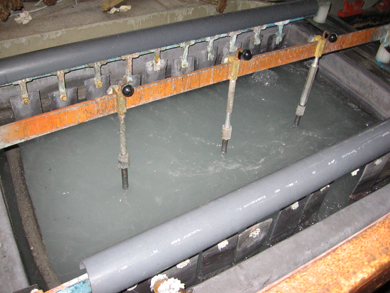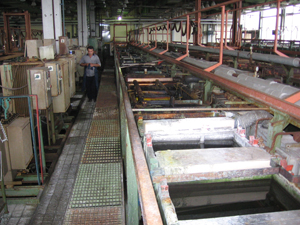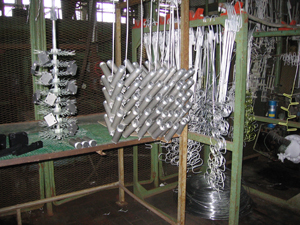Anodic Oxidation of Aluminum Alloys (Anodising)
There are three types of anodic oxidation performed in our facilities:
The maximum length of the part to be anodized is 1m. |
 |
 |
 |
The process of anodic oxidation in H2SO4 is applied when corrosion resistance, resistance to concentrated hydrogen peroxide, and good adhesion of paint, varnish and similar coatings are required, as well as for decorative purposes.
The process of anodic oxidation in H2SO4 is not applicable to assemblies, castings (other than ones containing more than 7% silicon), welded parts or bolted joints, objects of a complex configuration preventing the normal flow of the electrolyte, objects subject to wear, nor for aluminum sheets thinner than 0.25mm.
The process of anodic oxidation of CrO3 is applied when good corrosion resistance and minimal loss of strength to fatigue are required, also to detect cracks in the material, in cases of objects of complex configuration, ones that come into contact with explosive materials, or for the processing of objects with walls less than 1mm thick, castings containing less than 7% of silicon. It is also applied as an attachment surface for plastic materials, a substrate for organic coatings, combined with a hard anodic oxidation and for the processing of welded and riveted aluminum assemblies.
The process of anodic oxidation of the CrO3 is not applicable to assemblies which include non-aluminum parts (ones made of steel, copper alloys, organic materials, etc.), as well as to stressed objects (e.g. folded, or in a very curled position).
The process of hard anodic oxidation is applied when increased surface hardness is required, or in cases when a reduced friction and increased resistance to wear is needed at the sliding surfaces of objects, as well as to increase resistance to abrasion and corrosion.
The process of hard anodic oxidation is not applicable to alloys containing more than 2% copper and more than 7% silicon, or more than 8% of alloying elements, objects under operational load, components exposed to fatigue, as well as for aluminum sheet objects thinner than 1 mm, ones with welded or riveted joints and ones containing non-aluminum parts (ones made of steel, copper alloys, organic materials, etc.).
The technological process of hard anodic oxidation is the same as the one of anodic oxidation in sulfuric acid, but the operating modes and concentration of the ingredients are different. This layer is not chemically colored, unlike layer obtained by the process of anodic oxidation of H2SO4 .

 Srpski
Srpski